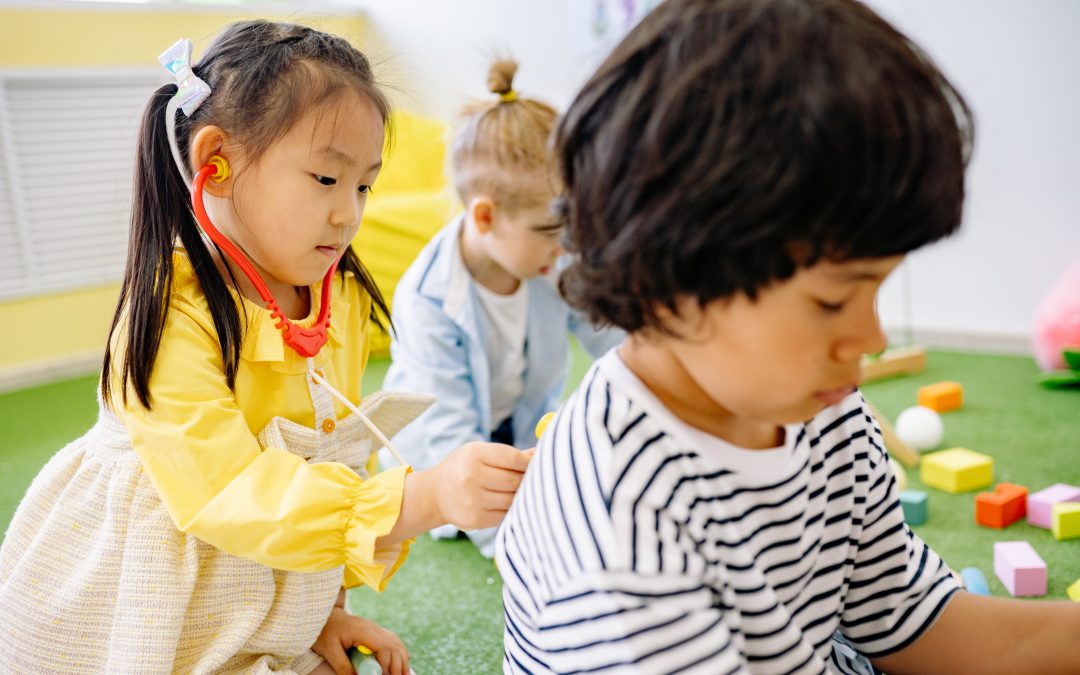Research shows that play offers an extensive array of benefits for children and adults alike. Many of these benefits relate to mental health. For example, play can reduce stress, strengthen brain function, and increase adaptability. Educators in early childhood development often use play to teach children both motor and social skills. This method of classroom teaching features loosely structured class time. Children learn through various activities and types of play that integrate motor and social skills. There’s also a strong connection between play-based learning and mental health.
Active Engagement
Play-based learning classrooms are lively. Children engage material with all five senses. They observe, listen to, and interact with learning objectives. This caters to all learning types: auditory, visual and kinesthetic. Classroom concepts shown through all three learning types address every student and their learning style. According to the Canadian Public Health Association, play-based learning can also help improve a child’s attention span. This is particularly true of students who may find it difficult to concentrate for extended periods of time.
They Have a Choice
In structured classroom settings, teachers end lessons and start playtimes. Play-based learning has a looser structure. Therefore, children focus on their own interests. They can choose their toys and organize play as they want. They have the freedom to switch to calmer activities if they feel overcome. This lessens frustrated melt-downs. This emphasis on children’s choices resembles the Montessori method. In Montessori’s method, the environment, teacher, and student are all important. Play-based learning, while even less structured than the Montessori method, is equally child-centered. This is why play-based learning is also called child-centered learning.
The Classroom Connects to Life
In play-based learning, children understand concepts by applying them. This relevant connection provides kids with context. Concordia University-Poland writes that children remember ideas when combined with play. Some may argue that play-based learning is uncertain, which may seem risky to students. However, this very uncertainty actually benefits students. Play offers students a safe space in which they can face risks and challenges. This in turn helps students develop coping skills necessary for facing adversity, making them more resilient in everyday life.
Learning Social Skills
Child-centered learning means children move around the classroom to interact with each other. Then, socializing can teach students important social skills, like teamwork and empathy for others. PBS expands on this in their piece on preschool philosophies. Play also helps children develop vital communication skills, including verbal communication and body language. Additionally, play teaches children how to cooperate with others and solve problems as a group. Therefore, play-based learning creates a safe environment in which students develop and refine crucial social skills.
Individuality is Encouraged
Play-based learning gives children choices through social play. Because of frequent choices, children develop the ability to recognize their needs. They can choose to play inside or outside, with blocks or with dolls. This environment fosters children’s vibrant personal identities. It can also lead students to be more accepting of others’ identities, choices, and personalities. In fact, evidence suggests that play can actually prevent bullying.
Play-Based Learning Online
Opportunities for play aren’t limited to the physical classroom. In fact, many teachers successfully incorporate play into virtual learning environments. Aidan Bybee, who teachers at a California charter school, developed iLEAD Through Play. This program offers engaging, accessible play-based learning activities. Bybee organizes online opportunities around different kinds of play, from ways to find one’s passion to designing experiments. During the pandemic, this fostered community and creativity, improving mental health.
Of course, any time students are online, it’s important to ensure that their digital learning environment is every bit as safe and nurturing as the physical classroom. Screen monitoring software, like LearnSafe, ensures a safe learning environment. LearnSafe detects instances of bullying and inappropriate contact. Also, LearnSafe serves as another tool to ensure student mental health. LearnSafe detects mentions of depression and suicidal ideation. But LearnSafe goes beyond detection. Our partners provide professional mental health screenings and tele-mental therapy services to help districts help students in crisis. LearnSafe keeps students safe, and it can also save student lives.
Text by Annika Bastian


